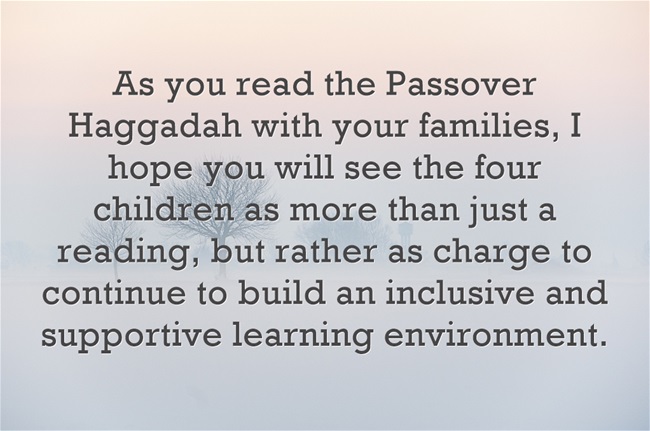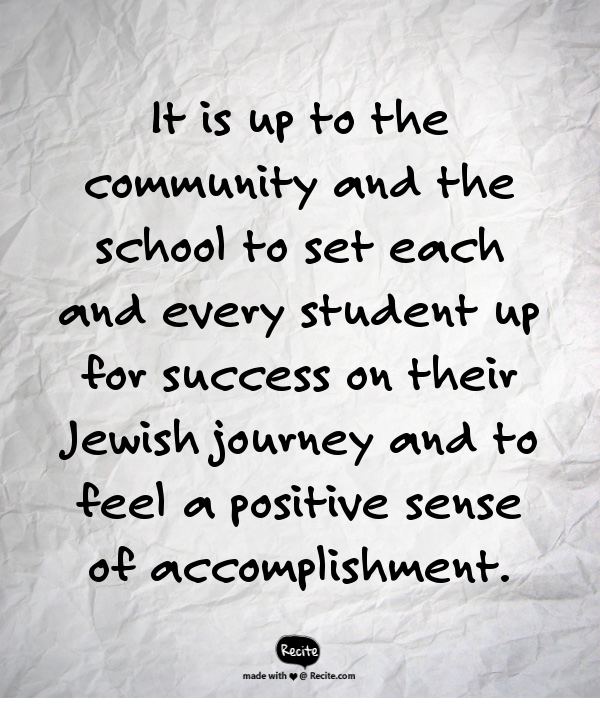 We are about to celebrate Pesach. In many of our homes, we have been cooking and cleaning and preparing to read the story of the Exodus from Egypt. We will share stories and memories of seders past and perhaps dream of seders to come. The reading of the Haggadah teaches more than the story of the Exodus, it teaches us about who we are as a people and how resilient we are. It also provides an entry into the world of education through the story of the Four Children.
We are about to celebrate Pesach. In many of our homes, we have been cooking and cleaning and preparing to read the story of the Exodus from Egypt. We will share stories and memories of seders past and perhaps dream of seders to come. The reading of the Haggadah teaches more than the story of the Exodus, it teaches us about who we are as a people and how resilient we are. It also provides an entry into the world of education through the story of the Four Children.
The Torah alludes to four children: one wise, one wicked, one simple and one who doesn’t know how to ask.
What does the wise child ask? “What are the precepts, statutes and laws that Adonai our God commanded you?” You should respond by answering that according to Halakhah it is forbidden to conclude the afikoman after the Passover offering.
What does the wicked child ask? “What is this service to you?” –“you” and not himself. By removing himself from the group, he misses the whole point. You should respond by chastising him and telling him, “This is what Adonai did for me when I left Egypt”—“for me” and not “for him,” for had he been there he would not have been redeemed.
What does the simple child ask? “What is this?” Answer him, “With a strong hand Adonai brought us out of the house of slaves.”
And the one who doesn’t know how to ask. You should start, for it says, “Tell your child on that very day: This is what Adonai did for me when I left Egypt.” Rabbi Lawrence Hoffman, My People’s Passover Haggadah, page 170.
Each of these children is represented in our Religious School. They bring their knowledge, attitudes and learning styles with them when they walk through our doors. Some enter curious and excited to learn. Others let us know that either they do not want to be here or that they think what we have to offer is meaningless to them. Some wonder why they are here. Finally, others haven’t formed the questions yet.
 For the two hours the students are in school, our faculty works hard to reach them and to teach them. The teachers use their understanding of educational techniques and their love of Judaism in order to guide our students along their journey to Jewish knowledge and understanding. They teach through role playing and games. They challenge the students with open-ended questions. The faculty encourages creative thinking and repetition (of Hebrew). Over the year, they have gotten to know each of their students along with their individual strengths and weaknesses.
For the two hours the students are in school, our faculty works hard to reach them and to teach them. The teachers use their understanding of educational techniques and their love of Judaism in order to guide our students along their journey to Jewish knowledge and understanding. They teach through role playing and games. They challenge the students with open-ended questions. The faculty encourages creative thinking and repetition (of Hebrew). Over the year, they have gotten to know each of their students along with their individual strengths and weaknesses.
Throughout this year, I have been privileged to participate in The Matan Institute’s Educator Training. Matan advocates for Jewish students with special needs, empowers their families, and educates Jewish leaders, teachers and communities so that all Jewish children have access to a rich and meaningful Jewish education. Through the in-person sessions, webinars and conference calls, Matan has provided me and CBY with tools for helping every student to succeed in our program. As a result of this training, we have made fidgets (small manipulative toys) available for the student who needs to be doing something with their hands in order to stay focused. The religious school iPads are being used in Hebrew tutoring for the auditory learners so they can record and listen to the prayers they are working on. When appropriate, I have shared Matan’s blogs and suggestions with the teachers to consider when they are preparing their lessons. There is still more to be done to make CBY totally inclusive of all students no matter how they learn, but we are moving in the right direction.
As the Haggadah teaches, there are four kinds of children who each learn differently. As a community, we have to respond to their questions in ways that each student will understand and help them to grow. In short, it is up to the community and the school to set each and every student up for success on their Jewish journey and to feel a positive sense of accomplishment.
As you read the Haggadah with your families, I hope you will see the four children as more than just a reading in the Haggadah but rather as charge to continue to build an inclusive and supportive learning environment at CBY.
May you and your family have a joyous Pesach.
This article was originally printed in March’s issue of the monthly bulletin of Congregation B’nai Yisrael.
 Rabbi Joan Glazer Farber is currently interim educator at Congregation B’nai Yisrael in Armonk, NY and the co-director of Hevreh: A Community of Adult Jewish Learners.
Rabbi Joan Glazer Farber is currently interim educator at Congregation B’nai Yisrael in Armonk, NY and the co-director of Hevreh: A Community of Adult Jewish Learners.
